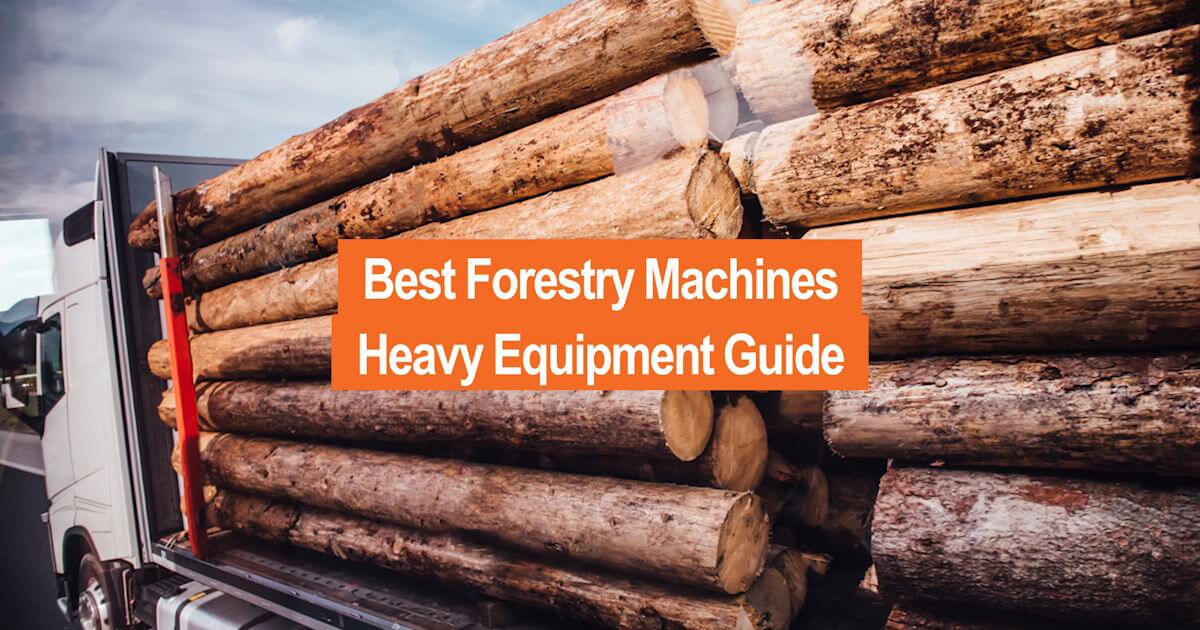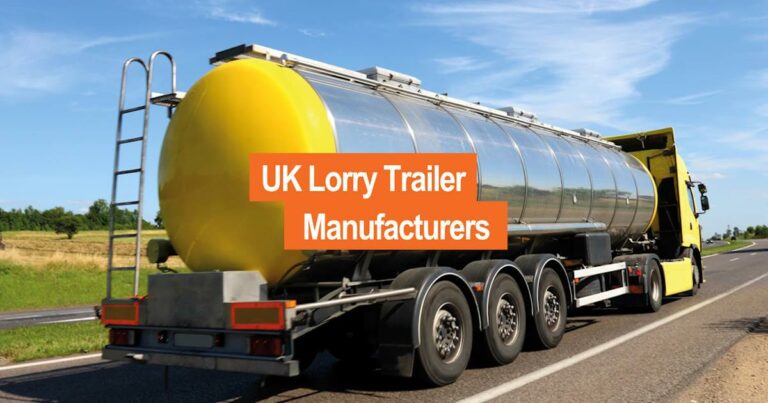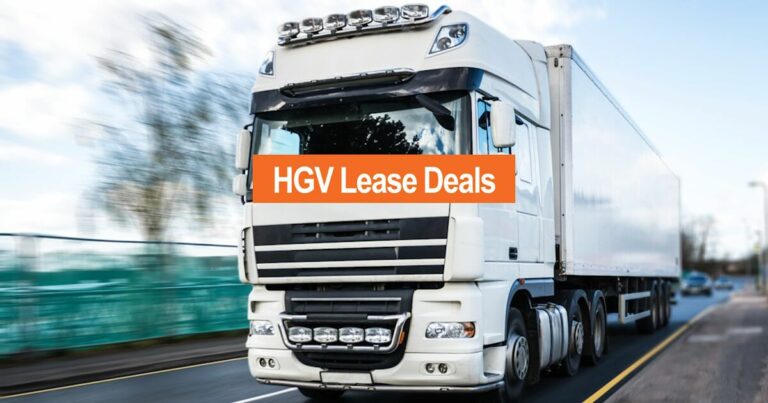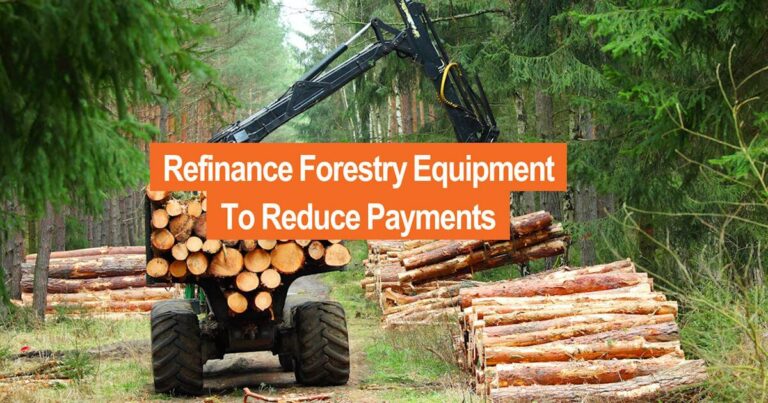Increase In Agricultural & Forest Machine Manufacturers
According to recent reports, the number of UK manufacturers of agricultural and forestry equipment stands at 600 businesses – an increase of 2.2% from the previous year. The report also highlighted a continual growth of approximately 2% each year since 2018.
The manufacturers say their new machines use GPS and real-time telematics to improve efficiency, use less fuel and are kinder to the woodlands. The companies claim they can cut down trees quicker (with less wastage) to allow operators to process/sell more timber.
With the demand for more efficient and automated machines, it is no wonder this amounted to £2.9 billion in UK sales revenue for 2023.
Types Of Forest Machines
Our team researched Mascus (mascus.co.uk) and Machinery Trader (machinerytrader.co.uk) to uncover the most popular pieces of equipment used in the forestry sector. After analysing data from both websites, we found that the following types of heavy equipment are the most popular:
Forestry Harvesters
These logging machines, in short, efficiently cut down and process trees and get them ready to transport out of the woodland.
Instead of a person having to fell each tree with a chainsaw manually, the harvester has a large mechanical saw blade attached to an articulating arm to cut through tree trunks quickly (in a matter of seconds). They also have a gripper/grapple arm to securely grip and move the felled trees.
Once the tree has been felled, the machine can delimb it, cut it into specific lengths, and stack the resulting logs into a pile. It can do the work of many loggers with chainsaws in a much more efficient and automated way.
These days, harvester cabs are fitted with GPS and computer systems, which allow the operator to manoeuvre through the forest to where trees need to be harvested based on a planned logging route.
Some models (and used prices) we discovered on the sites include:
- John Deere 1270G : £280,000 to £410,000
- Komatsu 901XC : £230,000
- Logset 8HGTE : £360,000
- Ponsse Ergo 8WD : £95,000
Forwarders
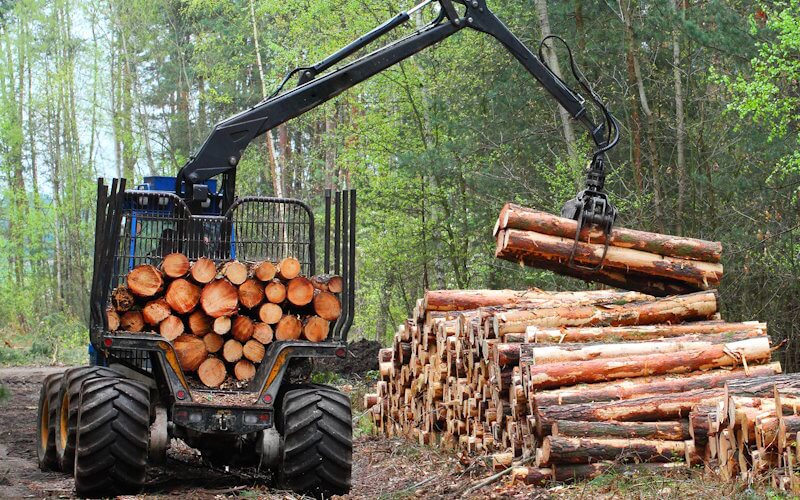
After trees are cut down and processed by the harvester into log piles, a forwarder machine lifts logs from the piles with its crane arm and loads them onto the back of its log trailer.
The forwarders are often 8-wheel-drive (or 6-wheel or semi-tracked), so they can drive over rough terrain, navigating to each log stack. Once loaded, they haul the cut logs to a roadside landing area, where logging trucks can collect them for delivery to sawmills.
Forwarders are seen as the “middlemen” as they continually shuttle in and out of the woodland to retrieve the log piles. Without them, it would be difficult to safely and quickly transport cut logs to the logging trucks.
The following models and prices were shown on the websites:
- John Deere 1510G : £120,000 to £235,000
- Ponsse Elephant 8W : £110,000
- Komatsu 835 : £122,000
- Kranman Bison 11000
Skidders
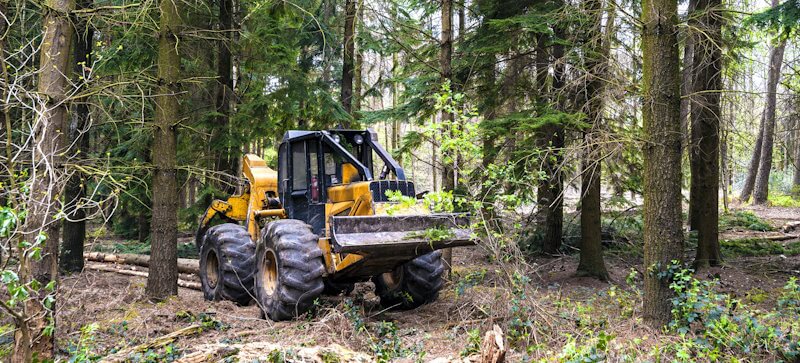
Whereas a forwarder actually uses an articulating crane arm and log bed to lift and haul logs, a skidder pulls multiple felled trees behind it from point A to point B.
It uses a grapple, or winch and cabling system, mounted on the back that attaches to felled trees, allowing a haul of trees to be dragged out of the forest to a central location for processing or transportation.
This allows the complete length of the tree to be removed in one piece, negating the need to cut it into smaller lengths to fit on a forwarder. Unfortunately, dragging can sometimes incur damage to the trees.
There was a much larger range of skidder manufacturers displayed on the sites, including:
- Noe NF210-6R
- Welte W130 K : £177,000
- Timberjack 4175A : £79,000
- John Deere 648H : £85,000
- GS Felix TWT 140 : £63,000
- Equus 175N £290,000
- Tigercat 630E : £43,000
Forestry Excavators
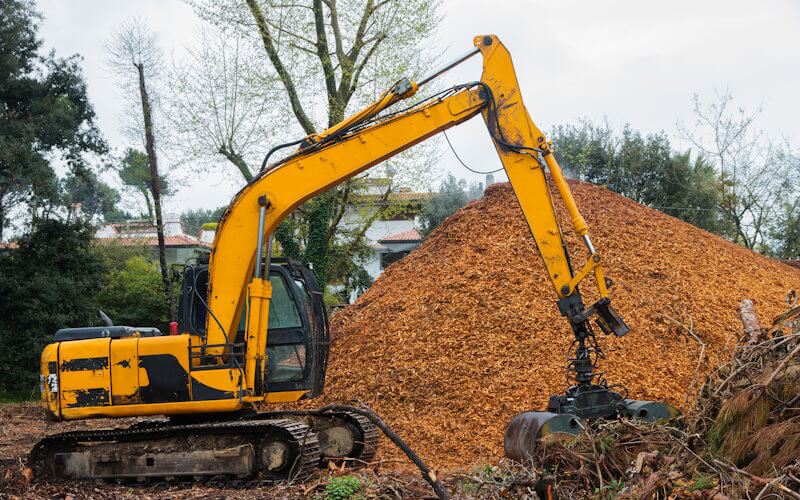
Forestry excavators (also known as Swing Machines) are heavy-duty logging machines with a long articulating arm to which different attachments can be added. They are commonly tracked vehicles but can also be wheeled. Many tend to have extra safety cages fitted around the operator’s cab to protect them from falling tree debris.
These rugged excavators can perform everyday tasks such as ripping out tree stumps, grading local terrain, digging drainage ditches, clearing pathways for equipment access, and performing demolition work such as breaking up debris.
If fitted with grabbers or clamshell buckets, they can grab multiple logs at once and stack them ready for processing or transporting out of the forest.
Excavators can also be fitted with harvesting heads or grapple saws to perform similar functions to harvesters or feller bunchers, allowing the excavator operator to fell trees and delimb branches.
The Mascus website offered a range of excavators for sale, including:
- Sany SY80U Harvadig : £110,000
- Kobelco SK 270 SR LC : £130,000
- Doosan 235 LCR : £85,000
- Hyundai 220LC-9R
Wood Chippers
When the harvesting equipment has completed felling usable trees for timber, it’s time to break out an industrial wood chipper to clean up the debris. Wood chippers are excellent for breaking up branches, scrub, small trees, and other wood waste into smaller pieces after the logging has finished.
The resulting wood chips are either spread across the forest floor as nutrients for other trees or collected for biomass fuel, landscaping mulch, animal bedding or pulp.
In one of our other guides, we investigated the best commercial wood chipper brands available to buy in the United Kingdom.
The Mascus website has many different brands of used chippers, such as:
- Heizohack HM6-300VM : £65,000
- Forst TR8D : £31,250
- Timberwolf TW190
- Laski 160 TR Tracked Chipper : £7,500
Common Attachments for Forestry Machinery
The two most common attachments, without doubt, are harvester heads and grapples. Our research showed that many of the used excavators on the Mascus website either came with a harvester head or grabble included in the price.
Harvester Heads
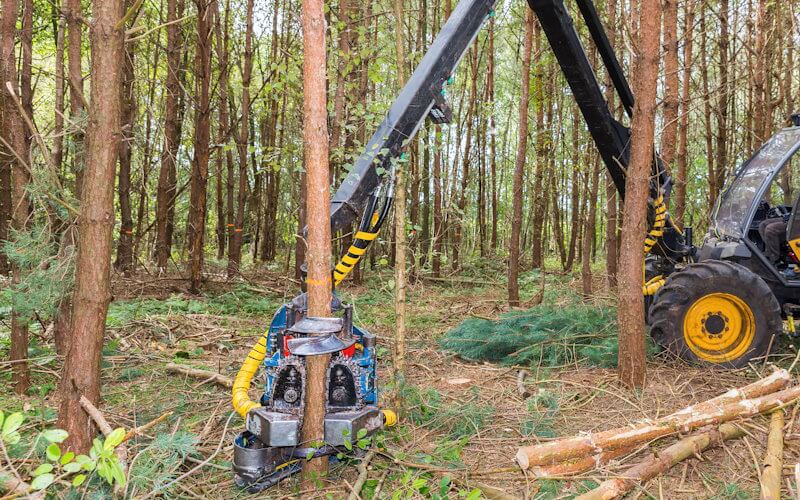
These interchangeable cutting attachments can be fitted to harvesters or suitable excavators. Designed to cut down trees quickly, the heads can also delimb and top them, as well as cut them into logs ready for transport.
These uniquely constructed cutters have a heavy-duty rotating saw disc (or saw bar) to rapidly chop through tree trunks (up to 30 inches thick). Behind the saw is a set of hydraulic feed rollers that grip and feed trees towards delimbing blades that strip off any branches. The head also incorporates a saw bar (like a chainsaw) to cross-cut the tree into preset lengths.
Harvester heads can also come without the rotating saw disc. Instead, a set of hydraulic cutting shears slices through the tree trunk to fall it. Models such as the Terratech TTS400 and JAK 400C Tree Shear are prime examples of this type of head. These tend to be used for smaller trees and fitted to smaller excavators.
Grapples
Grapple attachments, sometimes known as log grapples or forwarder grapples, can be mounted on the crane arm of forestry forwarders and excavators and make light work of moving trees and logs. The unique hinged claw-like fingers can gather and hold multiple logs at once.
Grapples come in various styles and designs, such as the Intermercato TG55 SR5, Mesera MF26, and PROFORGE Compact Log Grab.
Choosing the Best Forestry Equipment
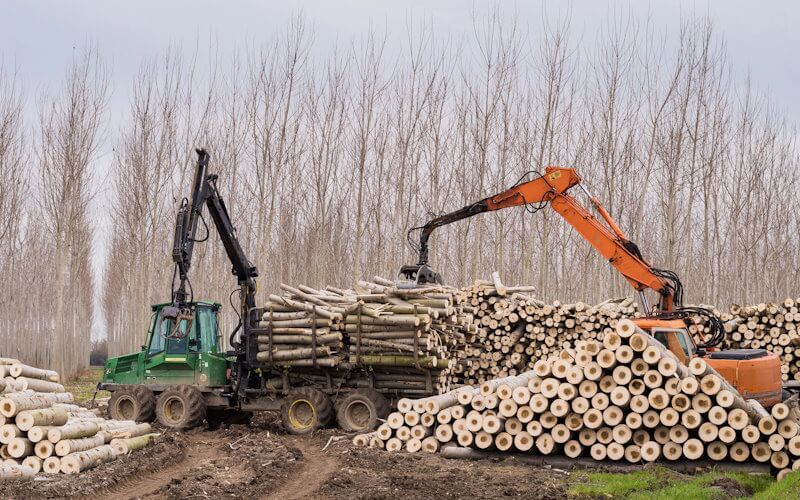
When you are about to finance any type of heavy-duty forestry machinery, there are some key factors to consider:
- Determine what jobs the equipment needs to handle (harvesting, delimbing, extraction, log loading, build access roads etc). Knowing what it needs to do will point you in the right direction.
- Evaluate the working area, tree size, log weights, and production/throughput to determine the size of the machine you need. Bigger is not always better.
- Evaluate the terrain on which the machine will be working. Steep slopes and challenging land conditions will likely require tracked vehicles with powerful engines or mud-capable tyres with chains.
- The machine’s efficiency is only as good as the operator, so ensure they are comfortable and safe. Modern covered and heated (air-conditioned) cabs provide optimal ergonomic conditions for the operator’s well-being during long days working in the elements. Rollover protection systems (ROPS) and grills should also be considered to protect them from flying debris.
- Having local maintenance and support facilities nearby will help minimise downtime, which eats into profits. Easy access to local dealer assistance and spare parts prolongs uptime. Remember that simpler machine designs tend to be more owner-serviceable than highly technical ones.
Finally, you also need to balance machine productivity versus owning/operating costs to maximise profitability. This is when different types of asset finance can help.
At Evangate FS we can arrange low rates and flexible terms for hire purchase, operating leases, contract hire, and asset loans. If you need help to arrange finance, we are positive our team can help.
Contact us today to find out.

